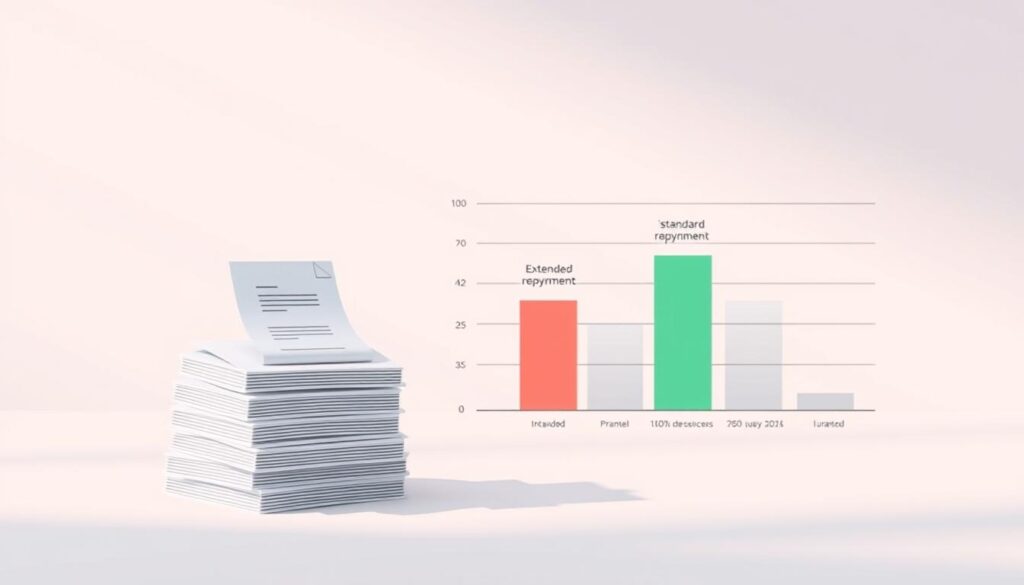Find the Right College Loan for Your Needs
Exploring higher education financing can feel overwhelming. But, it’s a key step to reach your academic dreams. Did you know the average student debt in the U.S. is over $30,000? This shows how vital it is to choose wisely when getting student loans.
Before you borrow, take some important steps first. Start by filling out the FAFSA form when it opens on October 1. Try to borrow less by cutting costs and looking for grants and scholarships. Also, think about working part-time or setting up a tuition plan to lessen your debt.
Key Takeaways
- Fill out the FAFSA form as soon as it opens on October 1 to maximize your financial aid eligibility.
- Explore ways to minimize borrowing, such as cutting costs and applying for grants and scholarships.
- Consider alternative options like working part-time or tuition installment plans.
- Understand the terms and conditions of your chosen student loan.
- Plan your finances carefully to avoid excessive debt.
Understanding College Loans
Exploring college loans can seem overwhelming. But, knowing your options is key to making smart choices. Let’s dive into the basics of college loans to help you make informed decisions.
What Are College Loans?
College loans are financial aids for students to cover education costs. They come from federal or private sources, each with its own benefits and rules. Understanding these loans is crucial for your financial aid decisions.
Types of College Loans
Students usually have two main loan options: federal loans or private loans from banks and credit unions. Federal loans include:
- Direct Subsidized Loans
- Direct Unsubsidized Loans
- Direct PLUS Loans
Private loans, offered by various lenders, have different terms and conditions.
Importance of Knowing Loan Terms
It’s essential to understand your loan terms to manage your debt well. Knowing the interest rates, repayment options, and forgiveness programs is key. This knowledge helps you make better financial aid choices and avoid problems.
Federal Student Loans
Federal student loans are a top pick for students. They come with good terms and flexible ways to pay back. The government offers these loans, which have lower interest rates and easier repayment plans than private loans.
Direct Subsidized Loans
Direct Subsidized Loans are for students who really need help. The government covers the interest while you’re in school at least half-time. This means you won’t pay interest until you graduate or go below half-time.
These loans are perfect for undergraduate students who show they need financial help.
Direct Unsubsidized Loans
Direct Unsubsidized Loans are for both undergrad and grad students, with or without financial need. But, you have to pay the interest from the start. You can pay it while in school or let it add up, which will increase when you start repaying.
Direct PLUS Loans
Direct PLUS Loans are for parents of undergrad students and for grad or professional students. They need a credit check and have a higher interest rate. But, they let you borrow more, which can be helpful if you need more money.
For more info on federal student loans, including who can get them and how to apply, check out Sallie Mae’s resource page. Knowing about the different federal loans and their perks can help you choose the right financial aid for you.
Key benefits of federal student loans include:
- Lower interest rates compared to private loans
- Flexible repayment options, including income-driven repayment plans
- Deferment and forbearance options for managing loan payments during financial hardship
- Potential for loan forgiveness under certain conditions
Private Student Loans
Understanding private student loans is key for students looking for college funding. These loans come from private lenders, not the government. They’re an option when federal loans aren’t enough.
How They Differ from Federal Loans
Private student loans are different from federal loans in many ways. They are offered by banks and credit unions, not the government. They might have variable interest rates and different repayment terms.
It’s important to compare rates from different lenders. Rates can change a lot.
Private loans often require a credit check and a co-signer for students. This is because students usually don’t have a credit history. Federal loans don’t usually need this.
When to Consider Private Loans
Think about private loans when federal loans aren’t enough. They’re good for covering extra costs like living expenses or study abroad programs.
But, it’s important to look at the loan terms carefully. Check the interest rate and repayment options. Students should also learn more about private student loans at this link before deciding.
Major Private Lenders
Many big lenders offer student loans with good rates and terms. Banks and financial institutions focus on helping students with higher education financing. When choosing a lender, compare their rates, repayment options, and customer service.
Students might also want to think about loan consolidation. It can make managing multiple loans easier and might lower monthly payments.
Loan Application Process
Getting financial aid for college is a big step. To do it right, you need to know what to do first.
Preparing Your Documents
Start by getting all your documents ready. You’ll need your Social Security number, driver’s license, tax returns, and W-2 forms. Having these ready makes the process easier.
Key Documents to Prepare:
- Identification documents
- Financial information (tax returns, W-2 forms)
- Proof of income
- Bank statements
Filling Out the FAFSA
For federal loans, start with the Free Application for Federal Student Aid (FAFSA). It shows if you qualify for aid. Make sure to fill it out right and on time.
“The FAFSA is a crucial document in determining your financial aid eligibility, so it’s vital to complete it accurately and on time.” –
Tips for Filling Out the FAFSA:
- Use the IRS Data Retrieval Tool to import tax information
- List all schools you’re applying to
- Report income and benefits accurately
Selecting a Lender
For private loans, picking the right lender is key. Look at rates, terms, and benefits from different lenders. Choose the one that best fits your needs.
| Lender | Interest Rate | Repayment Terms |
|---|---|---|
| Bank of America | 3.99% – 13.99% | 5 – 15 years |
| Wells Fargo | 4.25% – 14.75% | 5 – 15 years |
| Discover | 4.24% – 12.61% | 5 – 15 years |
When choosing a lender, think about interest rates, how flexible the repayment is, and the customer service.
By following these steps and being informed, you can confidently apply for loans. This will help you get the financial aid you need for college.
Interest Rates Explained
It’s key to understand interest rates when dealing with student loans. They affect how much you’ll pay back over time. Knowing how they work is vital.
When you get a student loan, you borrow more than just the principal. You also agree to pay back the principal plus interest. The interest rate is the percentage of the principal you’ll pay as interest each year.
Fixed vs. Variable Rates
Fixed interest rates stay the same for the loan’s life. This means your payments won’t change. But, variable interest rates can change with the market. This could make your payments go up or down.
Federal student loans usually have fixed interest rates set by law. This gives you a steady payment plan. Private loans, though, can have fixed or variable rates. This depends on the lender and your credit score.
How Rates Are Determined
Interest rates are set differently for federal and private loans. Federal student loans have rates set by Congress, which are fixed for the loan’s life. But, private lenders set their rates based on the market and your credit score.
Your credit score is very important for private loan rates. A better score can mean a lower rate. This can save you money on your loan.
Grasping these concepts is essential for handling your loan debt well. It helps you make smart choices about your financial aid.
Repayment Plans Overview
Choosing the right repayment plan is key to managing your student debt. It can be tough to pick from all the options. But, it’s crucial for keeping your finances stable.

Standard vs. Income-Driven Plans
There are mainly two repayment plans for federal student loans: Standard Repayment Plans and Income-Driven Repayment (IDR) Plans. Standard plans have a fixed payment for 10 years. They offer a simple way to pay off your loans.
Income-Driven Repayment plans, on the other hand, adjust your payments based on your income and family size. This can lower your monthly payments. These plans help those who are struggling financially or have a lot of debt.
Loan Forgiveness Options
For those who find it hard to repay, Loan Forgiveness Programs are available. These programs can wipe out part or all of your loan balance after you’ve made a certain number of payments. For example, Public Service Loan Forgiveness (PSLF) forgives loans after 120 payments for those in public service jobs.
It’s important to know if you qualify and how to apply for these programs. Check the specific rules for each forgiveness program to see if you’re eligible.
By looking into these repayment options and possibly combining them with forgiveness programs, you can make a plan that fits your finances. You might also consider loan consolidation or loan deferment to make payments easier or pause them temporarily.
Importance of Credit Score
Credit scores play a big role in the interest rates and terms you get on private student loans. Knowing how credit scores affect your loan options is key to smart financing choices for college.
How Your Credit Score Affects Loans
Lenders look closely at your credit score when they review your loan application. A high credit score shows you’re likely to pay back the loan. This can lead to better loan terms, like lower interest rates. On the other hand, a low credit score might mean higher interest rates or even a loan denial.
Impact of Credit Score on Loan Terms:
| Credit Score Range | Loan Terms | Interest Rate |
|---|---|---|
| 750+ | Favorable | Lower |
| 700-749 | Good | Competitive |
| 650-699 | Fair | Higher |
| Below 650 | Poor | High |
Tips for Improving Your Score
To boost your credit score, you need a solid plan. Here are some effective tips to help improve your score:
- Make timely payments on your existing debts.
- Keep your credit utilization ratio below 30%.
- Check your credit report for errors and dispute them if necessary.
- Avoid applying for too much credit in a short period.
By sticking to these tips and keeping a good credit score, you can get better terms on your private student loans. This makes paying for college easier.
Borrowing Wisely
Managing student debt starts with borrowing wisely. It’s important to understand your financial situation. Making smart choices about loans can shape your financial future.
Assessing Your Financial Situation
Before getting a loan, know your finances well. Look at your income, expenses, and future earnings. This helps you borrow what you can afford without financial stress after graduation.
Think about your future job and its salary. Jobs like engineering or medicine often pay well. This means you might be able to borrow more.
How Much to Borrow
It’s key to borrow the right amount. Don’t take the maximum loan available. Make a budget for tuition, living costs, and other needs to figure out how much to borrow.
Also, know the differences between student loans. Federal loans usually have better terms than private loans. They often have lower interest rates and more flexible repayment plans.
Managing Your Debt
Managing your debt well is important after borrowing for school. Understand your loan repayment options and pick one that suits you. Income-driven plans can help if you’re struggling to pay.
Keep track of your debt by knowing your financial aid options. You might even consolidate loans to make payments easier. Smart debt management can lessen its financial impact on you.
Scholarships and Grants
Scholarships and grants are great alternatives to loans for affordable higher education. They can greatly reduce the amount you need to borrow. This means less debt after you graduate.

Alternative Funding Sources
Scholarships and grants are types of financial aid that you don’t have to pay back. They come from many places, such as:
- Federal and state governments
- Educational institutions
- Private organizations and foundations
- Community groups
Looking into these different sources can help you find the funding you need for college.
How They Affect Loan Needs
Getting scholarships and grants can lower your need for college loans. This reduces your financial load and makes loan repayments easier on your future finances. Here are some benefits:
- Reduced debt: Less money to pay back means less debt.
- Financial flexibility: With less loan repayment, you have more freedom in your financial planning.
- Less financial stress: Lower loans mean less worry about money.
Knowing about and using higher education financing options like scholarships and grants can make college more affordable.
Common Mistakes to Avoid
Getting a college loan can be tricky. But knowing what to avoid can help. It’s important to steer clear of mistakes that can cause financial trouble.
Two big mistakes are taking out too much money and not understanding your loan. Knowing these can help you make better choices about your money.
Overborrowing
Overborrowing means taking out more loans than you need. This can lead to a big debt. It’s key to know how much you can afford to borrow.
- Calculate your total expenses, including tuition, fees, and living costs.
- Look for scholarships and grants before getting loans.
- Think about your future income and how it will help with loan repayment.
By thinking about these things, you can avoid too much debt. This will help you feel less stressed about money later.
Ignoring Loan Terms
Ignoring your loan terms can cause big money problems. It’s important to know the details of your loan. This includes the interest rate, how you’ll pay it back, and any options for deferment or forgiveness.
Loan repayment options can greatly affect your future. Learn about different plans, like income-driven ones. Understand how they work.
“Understanding your loan terms is crucial to managing your debt effectively. Take the time to read and comprehend your loan agreement.”
Also, knowing about loan deferment can help if you’re struggling financially. Knowing how to use these options can help you handle your debt better.
In short, avoiding mistakes like overborrowing and ignoring loan terms is key to managing your student loans well. By being informed and making smart choices, you can secure a stable financial future.
Resources for Students
Students can find many online tools and organizations to help with college loans. These resources guide them through getting and managing loans.
Online Tools and Calculators
Online tools and calculators are key for students dealing with college loans. They help estimate payments, understand financial aid, and plan for repayment. For example, loan calculators show monthly payments based on the loan amount, interest, and term.
- Loan Payment Calculators: These show monthly payment amounts.
- Financial Aid Estimators: Tools that estimate financial aid eligibility.
- Repayment Term Calculators: Determine repayment time under different plans.
Using these tools, students can make better financial decisions. This helps them manage their debt more effectively.
Supportive Organizations
There are also organizations that offer support and guidance for college loans. They provide resources like financial counseling and help with loan applications.
“The right guidance can make all the difference in a student’s ability to secure and manage their college loans effectively.”
Some notable organizations include:
- National Foundation for Credit Counseling (NFCC): Offers financial counseling, including student loan management.
- College Board: Provides resources on financing education, including scholarships, grants, and loans.
- Financial Aid organizations: Many colleges and universities have dedicated financial aid offices that offer support and guidance to students.
By using these resources, students can understand their loan options better. This helps them make informed decisions about financing their education.
Making Informed Decisions
Understanding college loans is key to a stable future. Knowing about private student loans and forgiveness programs is important. It can greatly affect your financial health.
Expert Guidance
Getting advice from experts is very helpful. They can guide you on managing your debt. They might suggest consolidating loans to simplify payments.
Community Engagement
Being part of student debates and forums is also good. Talking with others who face similar issues can offer new views. It keeps you updated on loan policies and forgiveness programs.
By staying informed and connected, we can make better choices about our college loans. This sets us up for financial success in the long run.









